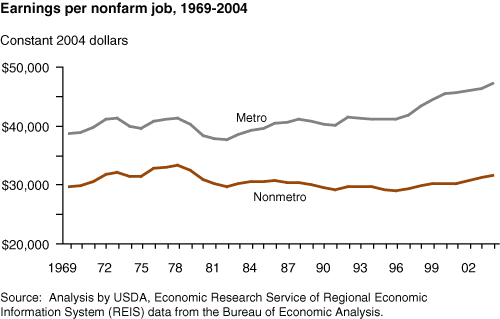Nonmetro Earnings Lag Metro
- by Timothy Parker
- 11/1/2006
Nonmetro earnings per job are an important indicator of how the rural economy is performing. In 2004, average earnings per nonfarm job in nonmetro areas were $31,582, versus $47,162 in metro areas. This gap is longstanding, and widening. Nonmetro earnings were 81 percent of metro earnings in 1979 but dropped to 67 percent by 2004.
Nonmetro earnings trail metro across all nonfarm industries. And a greater portion of metro jobs are in higher paying industries. In 2004, industry sectors with the greatest concentrations of higher paid, college-educated workers posted the largest shortfalls in nonfarm earnings per job. Nonmetro earnings in the finance and insurance sector, for instance, were 43 percent of metro earnings, information services earnings were 45.5 percent, and professional technical industry earnings were 49.7 percent. Earnings were more comparable in nonmetro transportation and warehousing (79.6 percent of metro), retail trade (74.6 percent), and accommodations/foodservice (73.1 percent).
Metro areas often have higher proportions of skilled, higher paid workers within industries, as well. In 2005, the proportion of nonmetro workers in higher paying professional and managerial occupations was 9.3 percentage points less than in metro areas. At the same time, a greater share of nonmetro employment is in lower paying blue-collar occupations.
The higher proportion of nonmetro part-time and multiple job holders also helps explain the metro-nonmetro earnings difference. About 18.3 percent of nonmetro workers held part-time jobs in the first half of 2006, versus 17.2 percent of metro workers. In addition, about 6.1 percent of nonmetro workers held more than one job, compared with 5 percent of metro workers.
Finally, greater distance from metro centers is associated with lower earnings and fewer job opportunities for educated workers. Access to centers of information, communication, trade, and finance enable a smaller economy to connect to national and international marketplaces. In nonmetro counties with an urban population between 10,000 and 49,999, earnings per job were 69 percent of metro, compared with 61.4 percent in nonmetro counties of less than 10,000.
Lower earnings, however, do not necessarily indicate that rural residents are worse off than their metro counterparts. The cost of living varies with geography, and nonmetro areas typically have lower costs than metro. For more information, see, “Adjusting for Living Costs Can Change Who Is Considered Poor.”
This article is drawn from:
- Rural Poverty & Well-Being. (n.d.). U.S. Department of Agriculture, Economic Research Service.
You may also like:
- Jolliffe, D. (2006, November 1). Adjusting for Living Costs Can Change Who Is Considered Poor. Amber Waves, U.S. Department of Agriculture, Economic Research Service.


